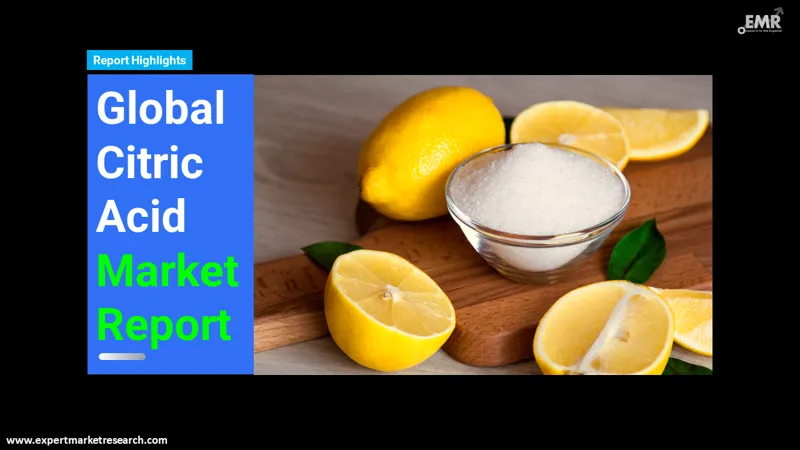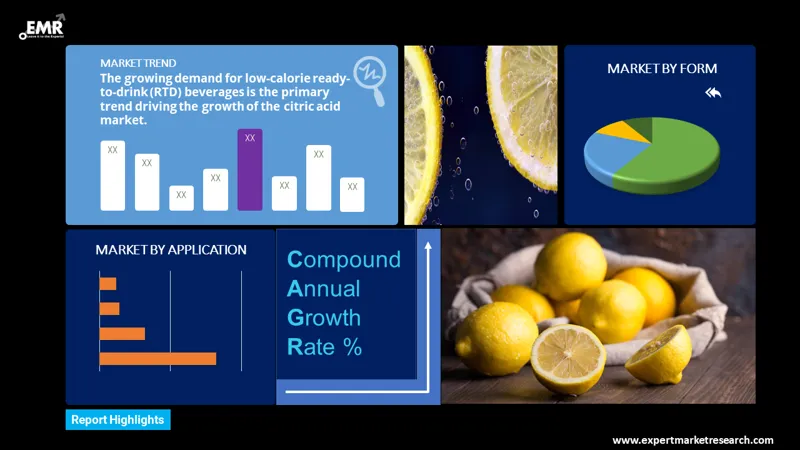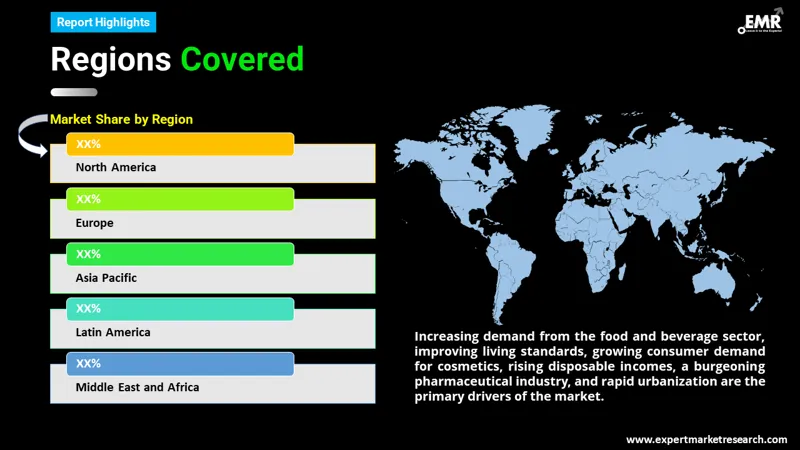Reports
Sale

Global Citric Acid Market Size, Share, Trends, Analysis: By Form: Anhydrous, Liquid; By Application: Food and Beverages, Household Detergents and Cleaners, Pharmaceuticals, Others; Regional Analysis; Market Dynamics: SWOT Analysis, Porter’s Five Forces Analysis; Value Chain Analysis; Competitive Landscape; 2024-2032
Global Citric Acid Market Outlook
The global citric acid market size stood at a volume of around 2.70 million tons in 2023. The market is assessed to grow at a CAGR of 4.1% in the forecast period of 2024-2032 to reach nearly 3.86 million tons by 2032.
Key Takeaways
- The global production of citric acid is currently estimated at 1.6 million tonnes annually, with 99% of this total being manufactured through microbial fermentation.
- In 2022, the leading importers of citric acid were the United States, Germany, Mexico, India, and the Netherlands.
- About 99% of the global manufactured citric acid supply is typically produced using the black mould fungus, Aspergillus niger.
Citric acid is a weak organic acid that is naturally found in citrus fruits like lemons, limes, oranges, and grapefruits. Its chemical formula is C6H8O7. It is well-known for its sour taste and is commonly used as a flavour enhancer and preservative in food and beverages. Beyond its culinary uses, citric acid is also used in cleaning agents, cosmetics, and pharmaceuticals, often for its ability to adjust acidity or stabilise other ingredients.
The market is currently being driven by the growing application of citric acid in several food and non-food industries such as beverages, confectioneries, convenience foods, dairy, pharmaceuticals, personal care and cosmetics, detergents and cleansers, and feed, among others. The growing consumer demand for RTD (ready-to-drink) beverages and processed foods is significantly aiding the citric acid market growth.

Read more about this report - REQUEST FREE SAMPLE COPY IN PDF
Key Trends and Developments
Citric acid's cross-sector applications; technological innovations; rapid urbanisation; and the use of citric acid in eco-friendly cleaning solutions are positively impacting the citric acid market expansion
Mar 1st 2024
Jungbunzlauer acquired AGI, a French company specialising in texturising solutions, to expand its portfolio in natural ingredient-based products.
Jan 24th 2024
Gadot Biochemical Industries launched Cal2Mag, a bone support blend of calcium and magnesium citrate, clinically shown to reduce arterial calcification risks.
Oct 2nd 2023
Biolage Professional introduced Bond Therapy, a salon haircare line combining citric acid and coconut oil to repair and strengthen over-processed hair.
May 4th 2023
Head & Shoulders unveiled BARE, a minimalistic anti-dandruff shampoo with only nine ingredients, offering effective scalp care and dandruff protection.
Increased Application of Citric Acid Across Different Sectors
Citric acid is widely used in food and beverage for preservation and flavour enhancement and is increasingly used in pharmaceuticals and personal care for its antioxidant and pH-adjusting properties.
Technological Advancements
Technological advancements, including green chemistry and tailored solutions, are poised to drive growth in the citric acid market in the forecast period.
Rising Demand for Citric Acid in Different Sectors
The citric acid market expansion is being aided by the increasing demand for the product in developing countries. This trend is attributed to several factors, including the growing middle class, rising disposable incomes, and shifting consumer preferences towards convenience foods and beverages.
Shift Towards Eco-friendly Cleaning Solutions
The trend towards eco-friendly cleaning products has made citric acid a preferred alternative to harsh chemicals due to its biodegradability and effectiveness in removing deposits.
Global Citric Acid Market Trends
The primary driver for the citric acid market growth is the booming global food and beverage industry. Citric acid's ability to naturally preserve food and enhance flavour continuity is indispensable, particularly in the manufacturing of soft drinks, fruit juices, and candies. Its demand is further reinforced by the rising consumer preference for food products with extended shelf lives and improved taste profiles.
In the pharmaceutical industry, citric acid is utilised for its properties as an acidulant, helping to stabilise active ingredients and adjust pH levels in medicines, making it essential for ensuring the effectiveness and stability of formulations. The growing pharmaceutical sector worldwide, supported by an ageing population and increasing healthcare spending, is driving the citric acid market expansion.

Read more about this report - REQUEST FREE SAMPLE COPY IN PDF
Market Segmentation
“Global Citric Acid Market Report and Forecast 2024-2032” offers a detailed analysis of the market based on the following segments:
Market Breakup by Form
- Anhydrous
- Liquid
Market Breakup by Application
- Food and Beverages
- Household Detergents and Cleaners
- Pharmaceuticals
- Others
Market Breakup by Region
- North America
- Europe
- Asia Pacific
- Latin America
- Middle East and Africa
Increasing application of anhydrous citric acid owing to its advantageous and stable properties is aiding the market
Anhydrous citric acid, a dry, powdered form of citric acid that is favoured for its stability and ease of storage and handling, is commonly used across multiple industries. This form is especially popular in food and beverage, pharmaceuticals, and cleaning products due to its concentrated properties. It is highly effective as a preservative, acidulant, and flavour enhancer, particularly in solid and dry formulations.
The food and beverage sector dominates the citric acid market share
The food and beverages sector represents the primary application for citric acid within the market. This compound is extensively utilised as a flavour enhancer, preservative, and acidulant across a diverse range of food products, such as soft drinks, candies, and baked goods. Its natural preservation qualities and ability to deliver a pleasing acidic flavour are essential, making it a vital ingredient in this industry.
Competitive Landscape
Major citric acid market players are increasingly adopting the latest technologies to enhance production capabilities
Archer Daniels Midland Company
Archer Daniels Midland Company (ADM) is a multinational food processing and commodities trading corporation. Founded in 1902, ADM is headquartered in Chicago, Illinois, USA. The company operates more than 270 plants and 420 crop procurement facilities worldwide, where cereal grains and oilseeds are processed into products used in the food, beverage, nutraceutical, industrial, and animal feed markets globally.
Cargill, Incorporated
Cargill is one of the largest privately-held corporations in the United States in terms of revenue. It was founded in 1865 and is headquartered in Minnetonka, Minnesota, USA. Cargill provides food, agriculture, financial, and industrial products and services throughout the world. With a vast network of operations that span several continents, Cargill is involved in various activities, including trading, purchasing, and distributing grain and other agricultural commodities.
Tate & Lyle PLC
Tate & Lyle PLC is a British-based global provider of ingredients and solutions to the food, beverage, and other industries. Founded in 1859, the company specialises in the production of sweeteners, starches, and other nutrition and biomaterial solutions. Tate & Lyle is headquartered in London, United Kingdom, and operates across a network of manufacturing plants around the world, focusing on innovation and sustainability in its products and processes.
Jungbunzlauer Suisse AG
Jungbunzlauer Suisse AG is a leading producer of biodegradable ingredients of natural origin. The company was founded in 1867 and is headquartered in Basel, Switzerland. Jungbunzlauer specialises in citric acid, xanthan gum, gluconates, lactates, and other speciality products, which are used in a wide range of industries, including food and beverage, personal care, pharmaceuticals, and more.
Other key players in the global citric acid market are COFCO, among others.
Many companies in the citric acid market are increasing their production capacities to meet the rising demand for citric acid in various industries such as food and beverages, pharmaceuticals, and personal care. By upgrading existing plants or building new facilities, these companies can ensure a steady supply of citric acid to their global clientele.
Moreover, players in the market are adopting advanced fermentation technologies that enhance yield and reduce waste. Additionally, some are exploring the use of genetically modified organisms (GMOs) to increase fermentation efficiency, although this approach is subject to regulatory approvals and public acceptance.

Read more about this report - REQUEST FREE SAMPLE COPY IN PDF
Global Citric Acid Market Analysis by Region
The Asia Pacific holds a major portion of the global citric acid market share. This dominance can be attributed to several factors. Countries in the region, especially China and India, have experienced significant industrial growth, which includes the food and beverage industry, pharmaceuticals, and cosmetics—all major users of citric acid.
Moreover, the growing middle class in these regions has led to increased demand for processed and convenience foods, where citric acid is often used as a preservative and flavouring agent.
Key Highlights of the Report
| REPORT FEATURES | DETAILS |
| Base Year | 2023 |
| Historical Period | 2018-2023 |
| Forecast Period | 2024-2032 |
| Scope of the Report |
Historical and Forecast Trends, Industry Drivers and Constraints, Historical and Forecast Market Analysis by Segment:
|
| Breakup by Form |
|
| Breakup by Application |
|
| Breakup by Region |
|
| Market Dynamics |
|
| Competitive Landscape |
|
| Companies Covered |
|
| Report Price and Purchase Option | Explore our purchase options that are best suited to your resources and industry needs. |
| Delivery Format | Delivered as an attached PDF and Excel through email, with an option of receiving an editable PPT, according to the purchase option. |
*At Expert Market Research, we strive to always give you current and accurate information. The numbers depicted in the description are indicative and may differ from the actual numbers in the final EMR report.
1 Preface
2 Report Coverage – Key Segmentation and Scope
3 Report Description
3.1 Market Definition and Outlook
3.2 Properties and Applications
3.3 Market Analysis
3.4 Key Players
4 Key Assumptions
5 Executive Summary
5.1 Overview
5.2 Key Drivers
5.3 Key Developments
5.4 Competitive Structure
5.5 Key Industrial Trends
6 Snapshot
6.1 Global
6.2 Regional
7 Industry Opportunities and Challenges
8 Global Citric Acid Market Analysis
8.1 Key Industry Highlights
8.2 Global Citric Acid Historical Market (2018-2023)
8.3 Global Citric Acid Market Forecast (2024-2032)
8.4 Global Citric Acid Market by Form
8.4.1 Anhydrous
8.4.1.1 Market Share
8.4.1.2 Historical Trend (2018-2023)
8.4.1.3 Forecast Trend (2024-2032)
8.4.2 Liquid
8.4.2.1 Market Share
8.4.2.2 Historical Trend (2018-2023)
8.4.2.3 Forecast Trend (2024-2032)
8.5 Global Citric Acid Market by Application
8.5.1 Food and Beverages
8.5.1.1 Market Share
8.5.1.2 Historical Trend (2018-2023)
8.5.1.3 Forecast Trend (2024-2032)
8.5.2 Household Detergents and Cleaners
8.5.2.1 Market Share
8.5.2.2 Historical Trend (2018-2023)
8.5.2.3 Forecast Trend (2024-2032)
8.5.3 Pharmaceuticals
8.5.3.1 Market Share
8.5.3.2 Historical Trend (2018-2023)
8.5.3.3 Forecast Trend (2024-2032)
8.5.4 Others
8.6 Global Citric Acid Market by Region
8.6.1 Market Share
8.6.1.1 North America
8.6.1.2 Europe
8.6.1.3 Asia Pacific
8.6.1.4 Latin America
8.6.1.5 Middle East and Africa
9 Regional Analysis
9.1 North America
9.1.1 Historical Trend (2018-2023)
9.1.2 Forecast Trend (2024-2032)
9.1.3 Breakup by Country
9.1.3.1 United States of America
9.1.3.2 Canada
9.2 Europe
9.2.1 Historical Trend (2018-2023)
9.2.2 Forecast Trend (2024-2032)
9.2.3 Breakup by Country
9.2.3.1 United Kingdom
9.2.3.2 Germany
9.2.3.3 France
9.2.3.4 Italy
9.2.3.5 Others
9.3 Asia Pacific
9.3.1 Historical Trend (2018-2023)
9.3.2 Forecast Trend (2024-2032)
9.3.3 Breakup by Country
9.3.3.1 China
9.3.3.2 Japan
9.3.3.3 India
9.3.3.4 ASEAN
9.3.3.5 Australia
9.3.3.6 Others
9.4 Latin America
9.4.1 Historical Trend (2018-2023)
9.4.2 Forecast Trend (2024-2032)
9.4.3 Breakup by Country
9.4.3.1 Brazil
9.4.3.2 Argentina
9.4.3.3 Mexico
9.4.3.4 Others
9.5 Middle East and Africa
9.5.1 Historical Trend (2018-2023)
9.5.2 Forecast Trend (2024-2032)
9.5.3 Breakup by Country
9.5.3.1 Saudi Arabia
9.5.3.2 United Arab Emirates
9.5.3.3 Nigeria
9.5.3.4 South Africa
9.5.3.5 Others
10 Market Dynamics
10.1 SWOT Analysis
10.1.1 Strengths
10.1.2 Weaknesses
10.1.3 Opportunities
10.1.4 Threats
10.2 Porter’s Five Forces Analysis
10.2.1 Supplier’s Power
10.2.2 Buyer’s Power
10.2.3 Threat of New Entrants
10.2.4 Degree of Rivalry
10.2.5 Threat of Substitutes
10.3 Key Indicators for Demand
10.4 Key Indicators for Price
11 Value Chain Analysis
12 Trade Data Analysis
12.1 Major Importing Countries
12.1.1 By Volume
12.1.2 By Value
12.2 Major Exporting Countries
12.2.1 By Volume
12.2.2 By Value
13 Price Analysis
13.1 North America Historical Price Trends (2018-2023) and Forecast (2024-2032)
13.2 Europe Historical Price Trends (2018-2023) and Forecast (2024-2032)
13.3 Asia Pacific Historical Price Trends (2018-2023) and Forecast (2024-2032)
13.4 Latin America Historical Price Trends (2018-2023) and Forecast (2024-2032)
13.5 Middle East and Africa Historical Price Trends (2018-2023) and Forecast (2024-2032)
14 Manufacturing Process
14.1 Detailed Process Flow
14.2 Operations Involved
14.3 Mass Balance
15 Project Requirements and Cost Analysis
15.1 Land, Location, and Site Development
15.2 Construction
15.3 Plant Machinery
15.4 Cost of Raw Material
15.5 Packaging
15.6 Transportation
15.7 Utilities
15.8 Manpower
15.9 Other Capital Investment
16 Project Economics
16.1 Capital Cost of the Project
16.2 Techno-Economic Parameters
16.3 Product Pricing and Margins Across Various Levels of the Supply Chain
16.4 Taxation and Depreciation
16.5 Income Projections
16.6 Expenditure Projections
16.7 Financial Analysis
16.8 Profit Analysis
17 Competitive Landscape
17.1 Market Structure
17.2 Key Players
17.3 Company Profiles
17.3.1 Archer Daniels Midland Company
17.3.1.1 Company Overview
17.3.1.2 Product Portfolio
17.3.1.3 Demographic Reach and Achievements
17.3.1.4 Certifications
17.3.2 Cargill, Incorporated
17.3.2.1 Company Overview
17.3.2.2 Product Portfolio
17.3.2.3 Demographic Reach and Achievements
17.3.2.4 Certifications
17.3.3 Tate & Lyle
17.3.3.1 Company Overview
17.3.3.2 Product Portfolio
17.3.3.3 Demographic Reach and Achievements
17.3.3.4 Certifications
17.3.4 Jungbunzlauer Suisse AG
17.3.4.1 Company Overview
17.3.4.2 Product Portfolio
17.3.4.3 Demographic Reach and Achievements
17.3.4.4 Certifications
17.3.5 COFCO
17.3.5.1 Company Overview
17.3.5.2 Product Portfolio
17.3.5.3 Demographic Reach and Achievements
17.3.5.4 Certifications
17.3.6 Others
18 Industry Events and Developments
List of Key Figures and Tables
1. Global Citric Acid Market: Key Industry Highlights, 2018 and 2032
2. Global Citric Acid Historical Market: Breakup by Form (Million Tons), 2018-2023
3. Global Citric Acid Market Forecast: Breakup by Form (Million Tons), 2024-2032
4. Global Citric Acid Historical Market: Breakup by Application (Million Tons), 2018-2023
5. Global Citric Acid Market Forecast: Breakup by Application (Million Tons), 2024-2032
6. Global Citric Acid Historical Market: Breakup by Region (Million Tons), 2018-2023
7. Global Citric Acid Market Forecast: Breakup by Region (Million Tons), 2024-2032
8. North America Citric Acid Historical Market: Breakup by Country (Million Tons), 2018-2023
9. North America Citric Acid Market Forecast: Breakup by Country (Million Tons), 2024-2032
10. Europe Citric Acid Historical Market: Breakup by Country (Million Tons), 2018-2023
11. Europe Citric Acid Market Forecast: Breakup by Country (Million Tons), 2024-2032
12. Asia Pacific Citric Acid Historical Market: Breakup by Country (Million Tons), 2018-2023
13. Asia Pacific Citric Acid Market Forecast: Breakup by Country (Million Tons), 2024-2032
14. Latin America Citric Acid Historical Market: Breakup by Country (Million Tons), 2018-2023
15. Latin America Citric Acid Market Forecast: Breakup by Country (Million Tons), 2024-2032
16. Middle East and Africa Citric Acid Historical Market: Breakup by Country (Million Tons), 2018-2023
17. Middle East and Africa Citric Acid Market Forecast: Breakup by Country (Million Tons), 2024-2032
18. Major Importing Countries by Volume
19. Major Exporting Countries by Volume
20. Major Importing Countries by Value
21. Major Exporting Countries by Value
22. North America Historical Price Trends and Forecast 2018-2032
23. Europe Historical Price Trends and Forecast 2018-2032
24. Asia Pacific Historical Price Trends and Forecast 2018-2032
25. Latin America Historical Price Trends and Forecast 2018-2032
26. Middle East and Africa Historical Price Trends and Forecast 2018-2032
27. Global Citric Acid Market Structure
In 2022, the market reached an approximate volume of 2.70 million tons.
The market is estimated to grow at a CAGR of 4.1% between 2024 and 2032.
The market is estimated to witness healthy growth during 2024-2032 to reach around 3.86 million tons by 2032.
The major drivers of the market include growing demand for citric acid from the food and beverage sector, improving living standards, and growing consumer demand for cosmetics.
The increasing demand for low-calorie RTD beverages and rapid urbanisation are key trends guiding the growth of the market.
The major regional markets are North America, Europe, the Asia Pacific, Latin America, and the Middle East and Africa.
Anhydrous and liquid are the major forms of citric acid in the market.
The different applications of citric acid are food and beverages, household detergents and cleaners, and pharmaceuticals, among others.
The major players in the market are Archer Daniels Midland Company, Cargill, Incorporated, Tate & Lyle, Jungbunzlauer Suisse AG, and COFCO, among others.
Mini Report
-
Selected Sections, One User
-
Printing Not Allowed
-
Email Delivery in PDF
-
Free Limited Customisation -
Post Sales Analyst Support -
50% Discount on Next Update
Single User License
-
All Sections, One User
-
One Print Allowed
-
Email Delivery in PDF
-
Free Limited Customisation -
Post Sales Analyst Support -
50% Discount on Next Update

Five User License
-
All Sections, Five Users
-
Five Prints Allowed
-
Email Delivery in PDF
-
Free Limited Customisation
-
Post Sales Analyst Support
-
50% Discount on Next Update
Corporate License
-
All Sections, Unlimited Users
-
Unlimited Prints Allowed
-
Email Delivery in PDF + Excel
-
Free Limited Customisation
-
Post Sales Analyst Support
-
50% Discount on Next Update
Any Question? Speak With An Analyst
View A Sample
Did You Miss Anything, Ask Now
Right People
We are technically excellent, strategic, practical, experienced and efficient; our analysts are hand-picked based on having the right attributes to work successfully and execute projects based on your expectations.
Right Methodology
We leverage our cutting-edge technology, our access to trusted databases, and our knowledge of the current models used in the market to deliver you research solutions that are tailored to your needs and put you ahead of the curve.
Right Price
We deliver in-depth and superior quality research in prices that are reasonable, unmatchable, and shows our understanding of your resource structure. We, additionally, offer attractive discounts on our upcoming reports.
Right Support
Our team of expert analysts are at your beck and call to deliver you optimum results that are customised to meet your precise needs within the specified timeframe and help you form a better understanding of the industry.


